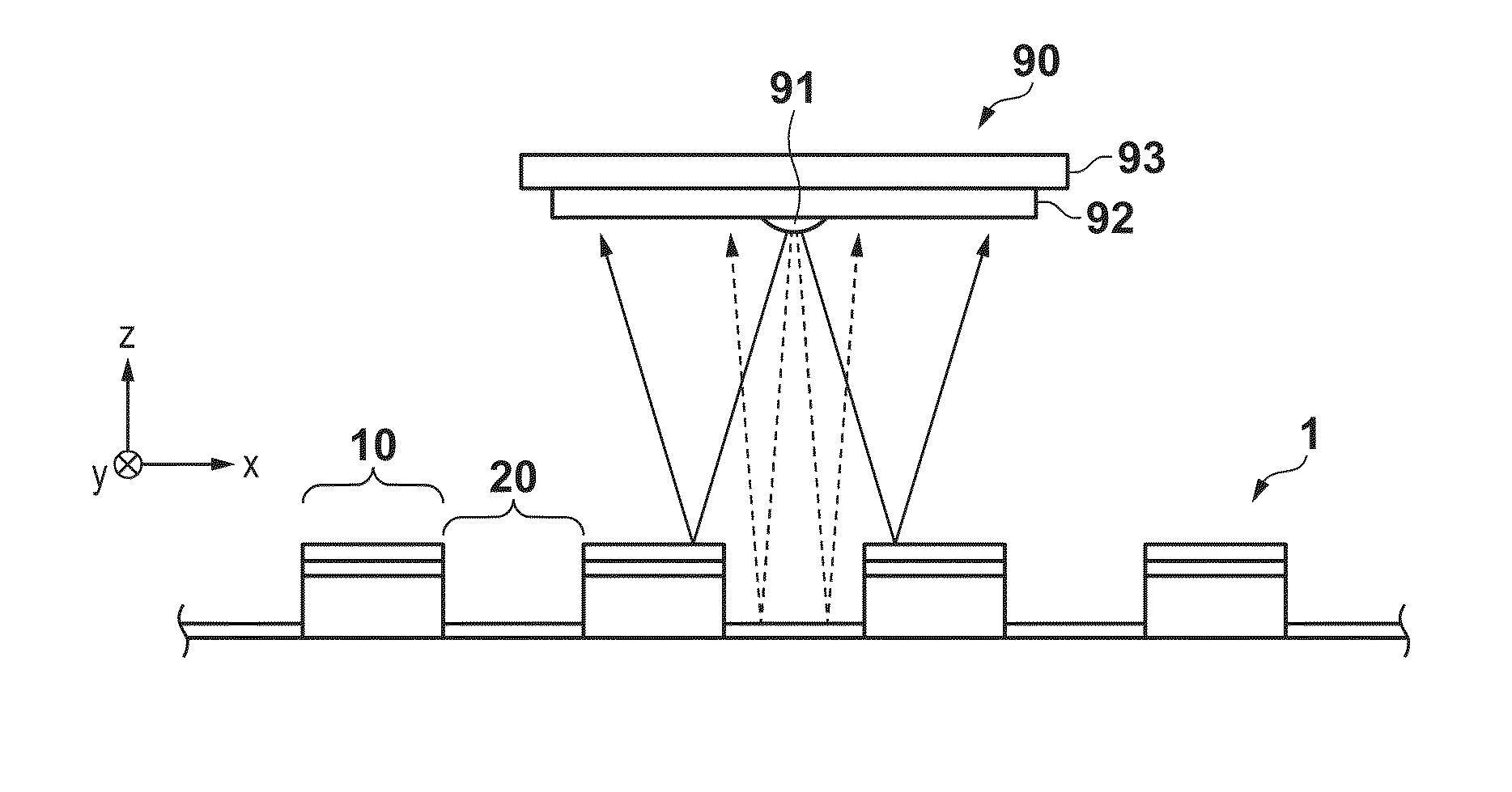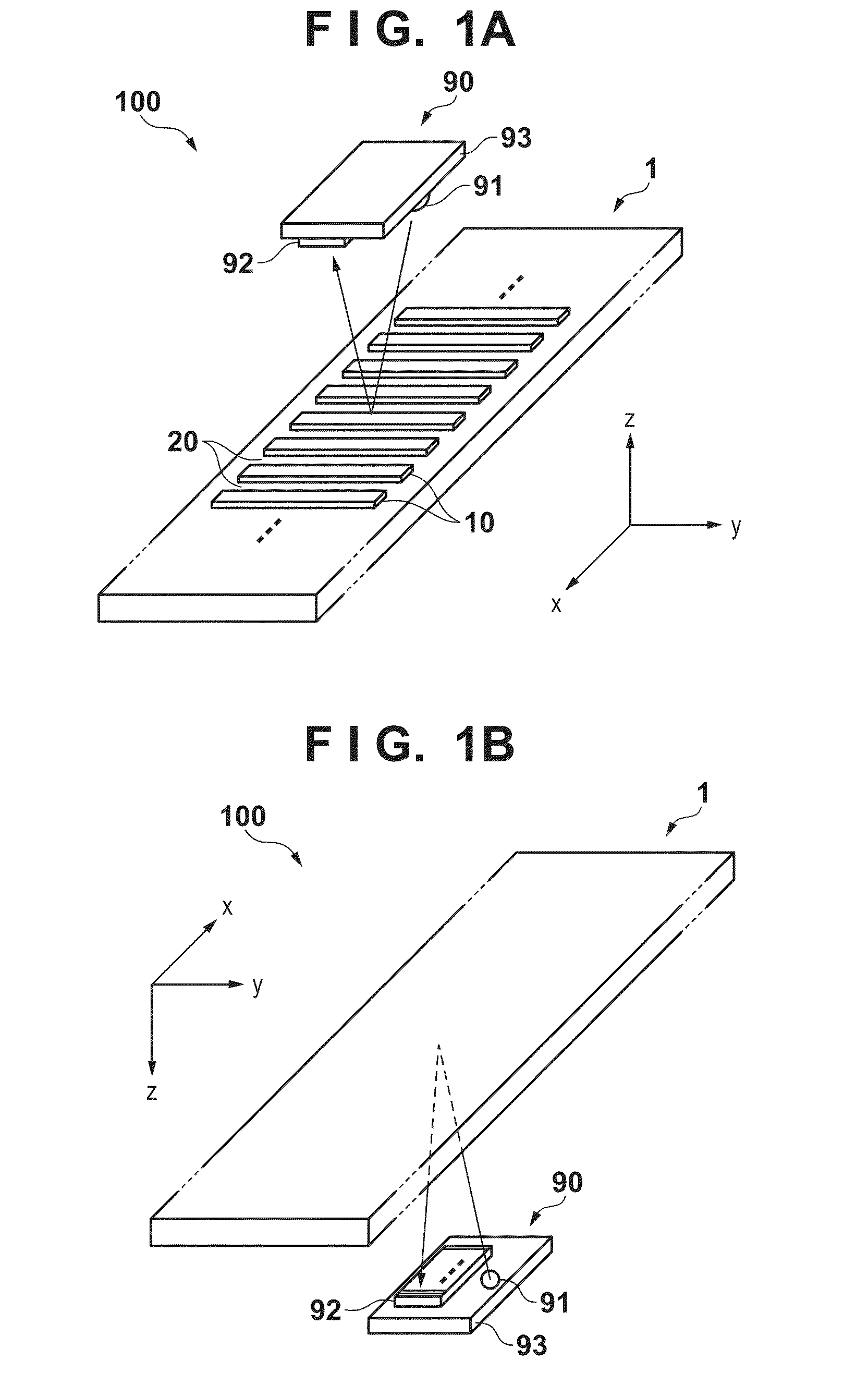Reflective optical scale for encoder and reflective optical encoder
a technology of reflective optical encoder and encoder, which is applied in the direction of optical elements, coatings, instruments, etc., can solve the problems of difficult to completely prevent the drop of reflectance light in these regions, and difficult to ensure the reflectance of light, so as to prevent the incorrect detection of light detectors and increase the contrast of images.
- Summary
- Abstract
- Description
- Claims
- Application Information
AI Technical Summary
Benefits of technology
Problems solved by technology
Method used
Image
Examples
first embodiment
[0016]A reflective optical scale 1 for an encoder according to the first embodiment of the present invention will be described below with reference to FIGS. 1A to 6C. FIGS. 1A and 1B are schematic views for explaining a reflective optical encoder 100. The reflective optical encoder 100 includes a reflective optical scale 1 and detection head 90. The reflective optical scale 1 and detection head 90 can be arranged to oppose each other. In FIG. 1A, the reflective optical scale 1 is illustrated at a lower position, and the detection head 90 is illustrated at an upper position. In FIG. 1B, the reflective optical scale 1 is illustrated at an upper position, and the detection head 90 is illustrated at a lower position. The detection head 90 includes a light source 91, a light detector 92, and a detection substrate 93 including them. The light source 91 is, for example, a point light source LED which has a small light-emitting surface and can emit light of a single wavelength λ. In the fol...
second embodiment
[0027]As another example of the underlying member 30, a member prepared by forming a film including at least one of chromium, titanium, nickel, iron, and platinum on a substrate having light transparency may be used. In this case, it is required to form a metal film as thick as incoming light from the light source 91 is not transmitted. FIG. 3B shows a reflective optical scale 2 according to the second embodiment of the present invention. In this embodiment, as the underlying member 30, a member prepared by forming a metal film 80 of chromium on a glass substrate 70 was used. The metal film 80 of chromium was formed to have a thickness of 100 nm or more. Therefore, light emitted by the light source 91 is never transmitted through this metal film 80, and does not cause any incorrect operation of the encoder 100 or the like. A refractive index of light of the metal film 80 of chromium is about 4.31.
[0028]FIG. 6B is a table showing comparison results of the reflective optical scale 2 f...
third embodiment
[0031]When a member prepared by forming a metal film on a glass substrate or the like is used as another example of the underlying member 30 as in the second embodiment, for example, a material having a high refractive index such as nickel, iron, or platinum can also be selected as a material of the metal film. FIG. 3C shows a reflective optical scale 3 for an encoder according to the third embodiment of the present invention. In this embodiment, a member prepared by forming a metal film 81 of titanium on a glass substrate 70 was used as the underlying member 30. The metal film 81 of titanium was formed to have a thickness of 100 nm or more. Compared to the second embodiment in which the metal film of chromium is formed, the light transmittance can be suppressed to 0.1% or less. Therefore, light emitted by the light source 91 is never transmitted through this metal film 81, and does not cause any incorrect operation of the encoder 100 or the like. A refractive index of light of the ...
PUM
| Property | Measurement | Unit |
|---|---|---|
| thickness | aaaaa | aaaaa |
| refractive index | aaaaa | aaaaa |
| refractive index | aaaaa | aaaaa |
Abstract
Description
Claims
Application Information
 Login to View More
Login to View More - R&D
- Intellectual Property
- Life Sciences
- Materials
- Tech Scout
- Unparalleled Data Quality
- Higher Quality Content
- 60% Fewer Hallucinations
Browse by: Latest US Patents, China's latest patents, Technical Efficacy Thesaurus, Application Domain, Technology Topic, Popular Technical Reports.
© 2025 PatSnap. All rights reserved.Legal|Privacy policy|Modern Slavery Act Transparency Statement|Sitemap|About US| Contact US: help@patsnap.com



